Green Roof for Stormwater Management in a Highly Urbanized Area: The Case of Seoul, Korea
Abstract
:1. Introduction
Green Roof as a Mitigation Strategy for Urban Water Related Problems
2. Study Objective and Approach
- To install the green roof to evaluate its potential for stormwater management in highly urbanized area.
- To quantify the rainfall runoff retention properties of the retrofitted green roof in Seoul, Korea.
3. Material and Methods
3.1. Site Description
3.2. Experimental Setup Detail
3.3. Overview of Data Record
3.4. Data Collection and Analysis
4. Results
4.1. Rainfall Runoff Attenuation
4.2. Overflow Outflows Measurement at the Ground Level
4.3. Water Level Measurement in Green Roof
4.4. Soil Moisture Measurement during Different Rain Events
5. Discussion
6. Conclusions
Acknowledgments
Author Contributions
Conflicts of Interest
References
- Mentens, J.; Raes, D.; Hermy, M. Green roofs as a tool for solving the rainwater runoff problem in the urbanized 21st century? Landsc. Urban Plan. 2006, 77, 217–226. [Google Scholar] [CrossRef]
- Stovin, V.; Vesuviano, G.; Kasmin, H. The hydrological performance of a green roof test bed under UK climatic conditions. J. Hydrol. 2012, 414, 148–161. [Google Scholar] [CrossRef]
- Stovin, V.; Poe, S.; Berretta, C. A modelling study of long term green roof retention performance. J. Environ. Manag. 2013, 131, 206–215. [Google Scholar] [CrossRef] [PubMed]
- Shafique, M.; Lee, D.; Kim, R. Roof Runoff Control by Using the Green Blue Roof and Blue Roof in the Urban Area. Available online: http://onlinepresent.org/proceedings/vol136_2016/5.pdf (accessed on 20 September 2017).
- Shafique, M.; Lee, D.; Kim, R. A Field Study to Evaluate Runoff Quantity from Blue Roof and Green Blue Roof in an Urban Area. Int. J. Control Autom. 2016, 9, 59–68. [Google Scholar] [CrossRef]
- Shafique, M.; Kim, R.; Lee, D. The Potential of Green-Blue Roof to Manage Storm Water in Urban Areas. Nat. Environ. Pollut. Technol. 2016, 15, 715–719. [Google Scholar]
- Xu, T.; Sathaye, J.; Akbari, H.; Garg, V.; Tetali, S. Quantifying the direct benefits of cool roofs in an urban setting: reduced cooling energy use and lowered greenhouse gas emissions. Build. Environ. 2011, 48, 1–6. [Google Scholar] [CrossRef]
- Getter, K.L.; Bradley, R.D.; Cregg, B.M. Solar radiation intensity influences extensive green roof plant communities. Urban For. Urban Green. 2009, 8, 269–281. [Google Scholar] [CrossRef]
- Sailor, D.J. A green roof model for building energy simulation programs. Energy Build. 2008, 40, 1466–1478. [Google Scholar] [CrossRef]
- Ondimu, S.N.; Murase, H. Combining Galerkin methods and neural network analysis to inversely determine thermal conductivity of living green roof materials. Biosyst. Eng. 2007, 96, 541–550. [Google Scholar] [CrossRef]
- Voyde, E.; Fassman, E.; Simcock, R. Hydrology of an extensive living roof under sub-tropical climate conditions in Auckland, New Zealand. J. Hydrol. 2010, 394, 384–95. [Google Scholar] [CrossRef]
- Badescu, V.; Sicre, B. Renewable energy for passive house heating: II. Model. Energy Build. 2003, 35, 1085–1096. [Google Scholar] [CrossRef]
- Francis, R.A.; Lorimer, J. Urban reconciliation ecology: the potential of living roofs and walls. J. Environ. Manag. 2011, 92, 1429–1437. [Google Scholar] [CrossRef] [PubMed]
- Spolek, G. Performance monitoring of three eco roofs in Portland, Oregon. Urban Ecosyst. 2008, 11, 349–359. [Google Scholar] [CrossRef]
- Palla, A.; Gnecco, I.; Lanza, L.G. Hydrologic restoration in the urban environment using green roofs. Water 2010, 2, 140–154. [Google Scholar] [CrossRef]
- Berndtsson, J.C. Green roof performance toward management of runoff water quantity and quality: A review. Ecol. Eng. 2010, 36, 351–360. [Google Scholar] [CrossRef]
- EPA (Environmental Protection Agency). Reducing Stormwater Costs through Low Impact Development (LID): Strategies and Practices; EPA 841-F-07F0006; U.S. Environmental Protection Agency: Washington, DC, USA, 2007.
- Banting, D.; Doshi, H.; Li, J.; Missios, P. Report on the Benefits and Costs of Green Roof Technology for the City of Toronto. Available online: https://web.toronto.ca/wp-content/uploads/2017/08/8f39-Report-on-the-Environmental-Benefits-and-Costs-of-Green-Roof-Technology-for-the-City-of-Toronto-Full-Report.pdf (accessed on 10 October 2017).
- Grant, G.; Engleback, L.; Nicholson, B.; Gedge, D.; Frith, M.; Harvey, P. Green Roofs: Their Existing Status and Potential for Conserving Biodiversity in Urban Areas. Engl. Nat. Res. Rep. 2003, 498, 9–59. [Google Scholar]
- Köhler, M. Green Roof Technology—From a Fire-Protection System to a Central Instrument in Sustainable Urban Design. In Proceedings of the 2nd Green Roof Conference, Portland, OR, USA, 2–4 June 2004. [Google Scholar]
- Herman, R. Green roofs in Germany: Yesterday, Today and Tomorrow. In Proceedings of the Greening Rooftops for Sustainable Communities, Chicago, IL, USA, 29–30 May 2003; pp. 41–45. [Google Scholar]
- Moon, T.H. Green growth policy in the Republic of Korea: Its promise and pitfalls. Korea Obs. 2010, 41, 379–386. [Google Scholar]
- Van, S.T.; Rocha, L.; Smith, D.; MacMillan, G. Evaluation of green roofs for runoff retention, runoff quality and leachability. Water Qual. Res.J. Can. 2009, 44, 33–41. [Google Scholar]
- Fioretti, R.; Palla, A.; Lanza, L.G.; Principi, P. Green roof energy and water related performance in the Mediterranean climate. Build. Environ. 2010, 45, 1890–1904. [Google Scholar] [CrossRef]
- Palla, A.; Sansalone, J.J.; Gnecco, I.; Lanza, L.G. Storm water infiltration in a monitored green roof for hydrologic restoration. Water Sci. Technol. 2011, 64, 766–773. [Google Scholar] [CrossRef] [PubMed]
- Carter, T.L.; Rasmussen, T.C. Hydrologic behaviour of vegetated roofs. J. Am. Water Resour. Assoc. 2006, 42, 1261–1274. [Google Scholar] [CrossRef]
- Morgan, S.; Celik, S.; Retzlaff, W. Green roof storm-water runoff quantity and quality. J. Environ. Eng. 2012, 139, 471–478. [Google Scholar] [CrossRef]
- Getter, K.L.; Rowe, D.B.; Andresen, J.A. Quantifying the effect of slope on extensive green roof stormwater retention. Ecol. Eng. 2007, 31, 225–231. [Google Scholar] [CrossRef]
- Carpenter, D.D.; Kaluvakolanu, P. Effect of roof surface type on storm-water runoff from full-scale roofs in a temperate climate. J. Irrig. Drain. Eng. 2011, 137, 161–169. [Google Scholar] [CrossRef]
- Fassman-Beck, E.; Voyde, E.; Simcock, R.; Hong, Y.S. 4 Living roofs in 3 locations: Does configuration affect runoff mitigation? J. Hydrol. 2013, 490, 11–20. [Google Scholar] [CrossRef]
- Bengtsson, L. Peak flows from thin sedum-moss roof. Hydrol. Res. 2005, 36, 269–280. [Google Scholar]
- Köehler, M. Urban storm water management by extensive green roofs. In Proceedings of the World Green Roof Congress/Welt Gründach-Kongress, Basel, Switzerland, 15–16 September 2005; pp. 150–156. [Google Scholar]
- Centgraf, S.C.; Schmidt, M. Water management to save energy. A decentralized approach to an integrated sustainable urban development. In Proceedings of the Rio5-World Climate and Energy Event, Rio de Janeiro, Brazil, 17 February 2005. [Google Scholar]
- Tillinger, D.; Ostroff, G.; Beattie, D.; Berghage, R.; Mankiewicz, P.; Montalto, F. Hydrologic functions of green roofs in New York City. In Green Roofs in the New York metropolitan region: Research Report. Columbia University Center for Climate System Research and NASA Goddard Institute for Space Study; Columbia University Center for Climate Systems Research: New York, NY, USA, 2006; pp. 27–36. Available online: https://pubs.giss.nasa.gov/docs/2006/2006_Rosenzweig_ro05800e.pdf (accessed on 10 October 2017).
- Prowell, E.S. An Analysis of Storm Water Retention and Detention pf Modular Green Roof Blocks. Master’s Thesis, University of Georgia, Athens, GA, USA, 2006. [Google Scholar]
- Shin, E.; Kim, H. Analysing Green Roof Effects in an Urban Environment: A Case of Bangbae-dong, Seoul. J. Asian Archit. Build. Eng. 2015, 14, 315–322. [Google Scholar] [CrossRef]
- Lee, J.Y.; Lee, M.J.; Han, M. A pilot study to evaluate runoff quantity from green roofs. J. Environ. Manag. 2015, 152, 171–176. [Google Scholar] [CrossRef] [PubMed]
- The Seoul Metropolitan Government Population Historically 2017. Available online: http://english.seoul.go.kr/get-to-know-us/seoul-views/meaning-of-seoul/4-population/ (accessed on 24 December 2017).
- Kim, R. Low Impact Development and Green Infrastructure in South Korea: Trends and Future Directions. Ecol. Resil. Infrastruct. 2016, 3, 80–91. (In Korean) [Google Scholar] [CrossRef]
- Korea Metrological Administration (KMA) 2007. Available online: http://web.kma.go.kr/eng/weather/climate/worldclimate.jsp (accessed on 23 December 2017).
- Sims, A.W.; Robinson, C.E.; Smart, C.C.; Voogt, J.A.; Hay, G.J.; Lundholm, J.T.; O’Carroll, D.M. Retention performance of green roofs in three different climate regions. J. Hydrol. 2016, 542, 115–124. [Google Scholar] [CrossRef]
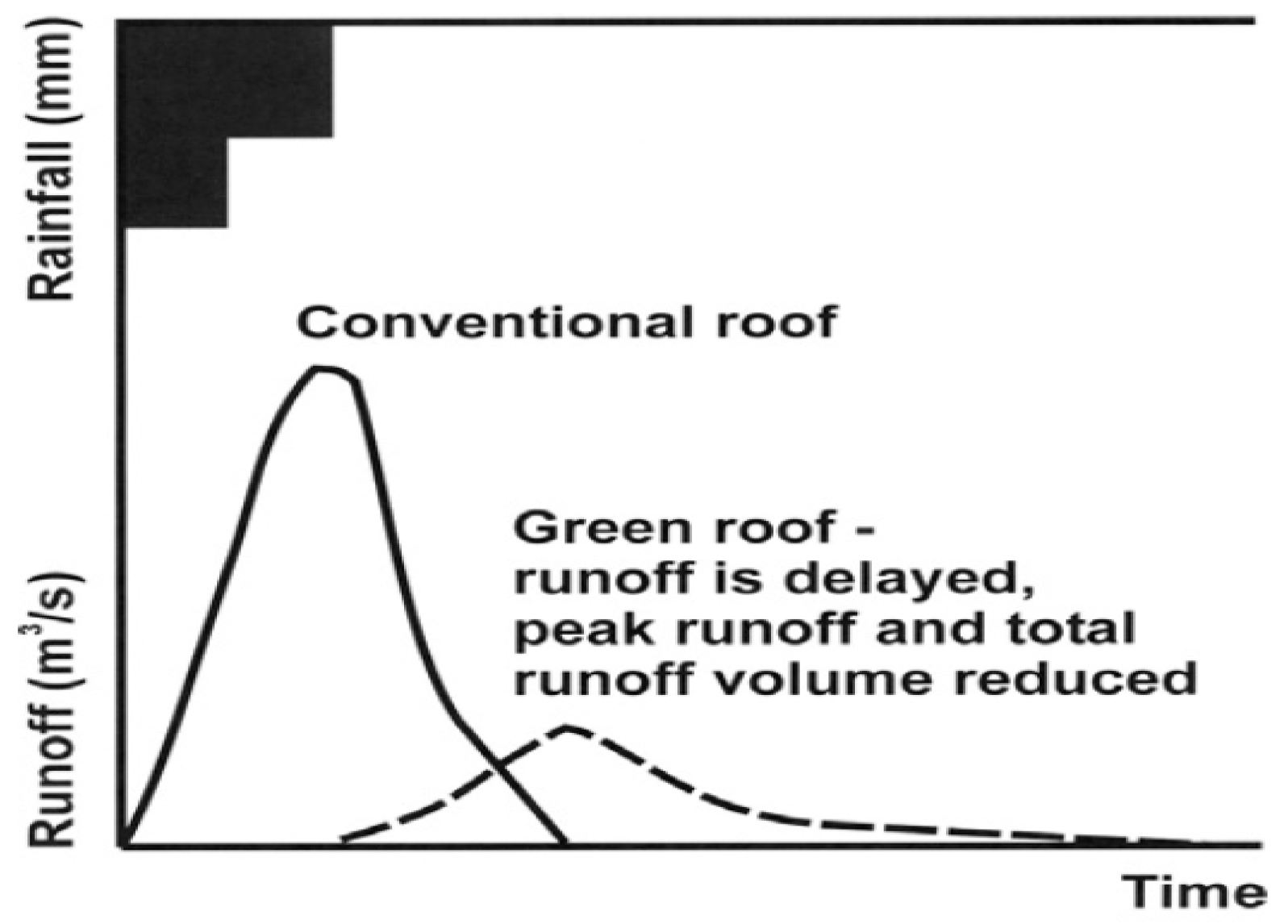
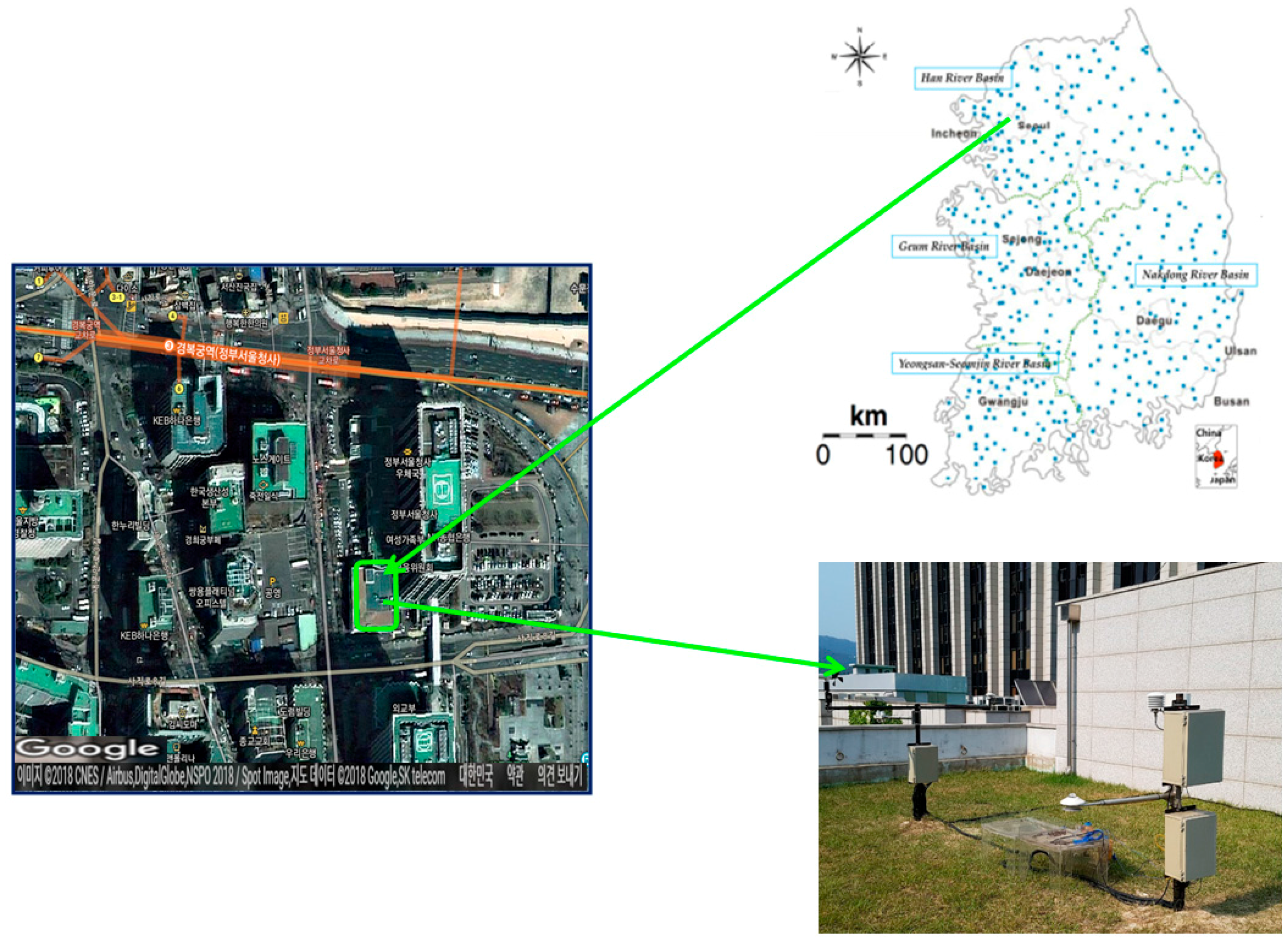
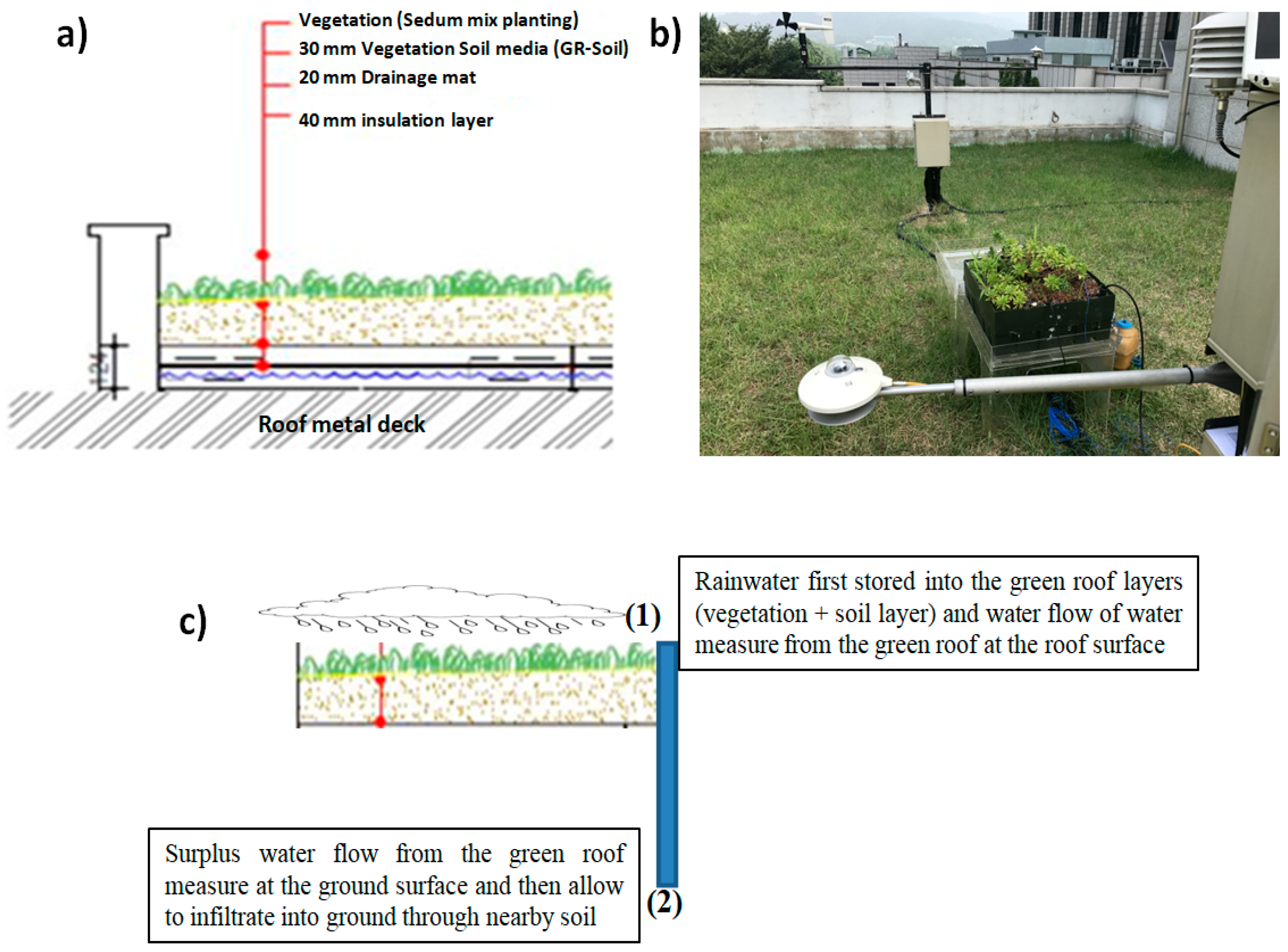
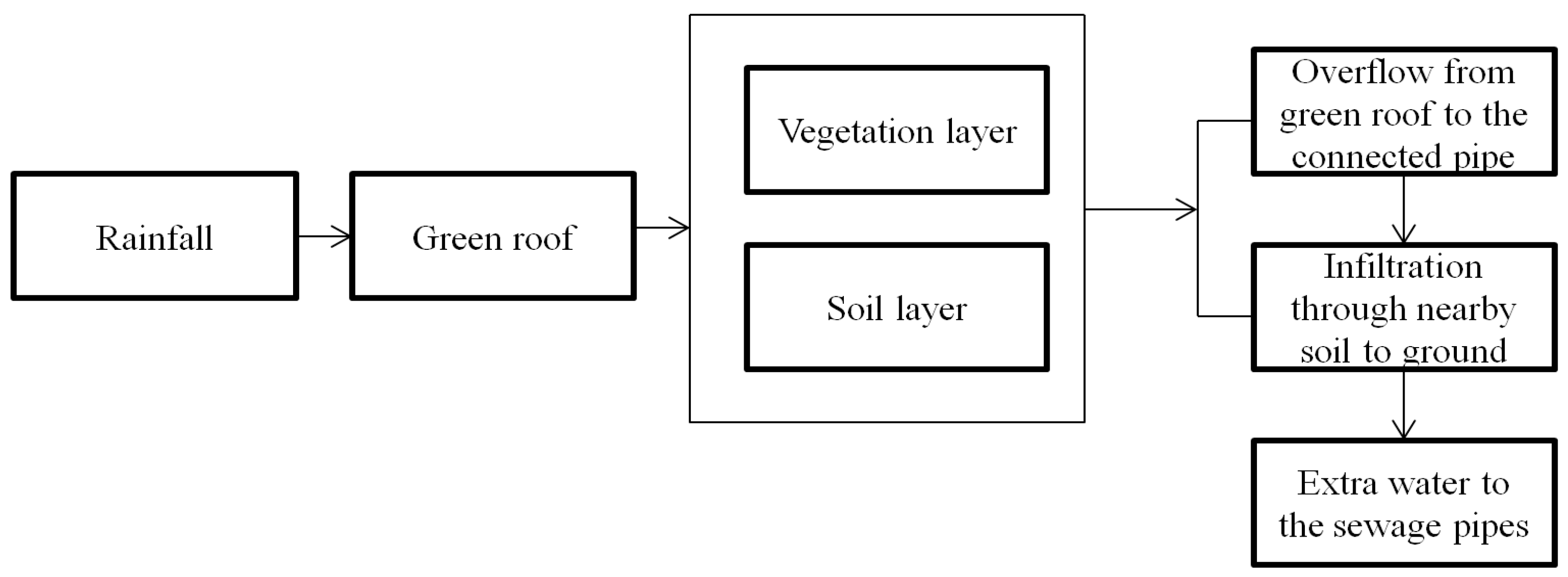

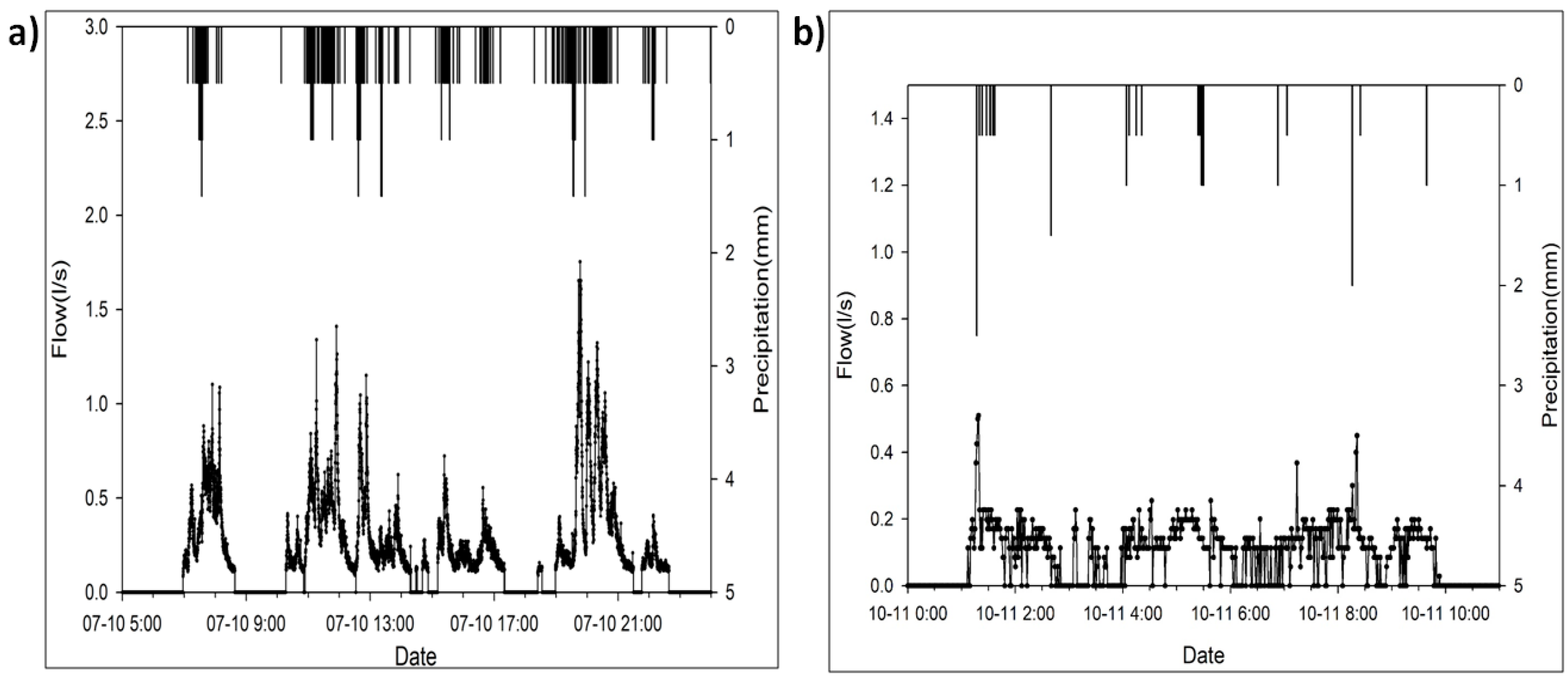
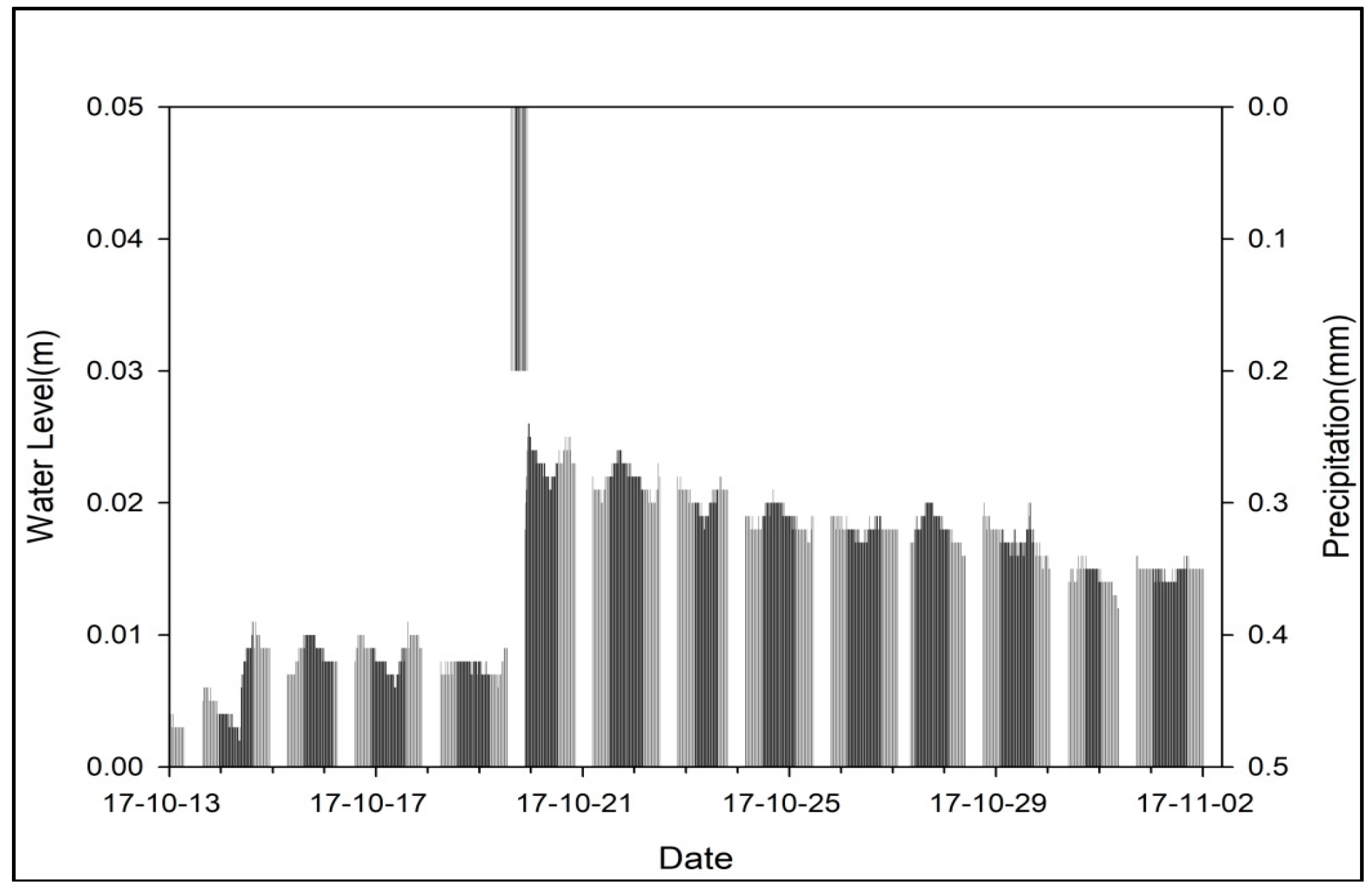
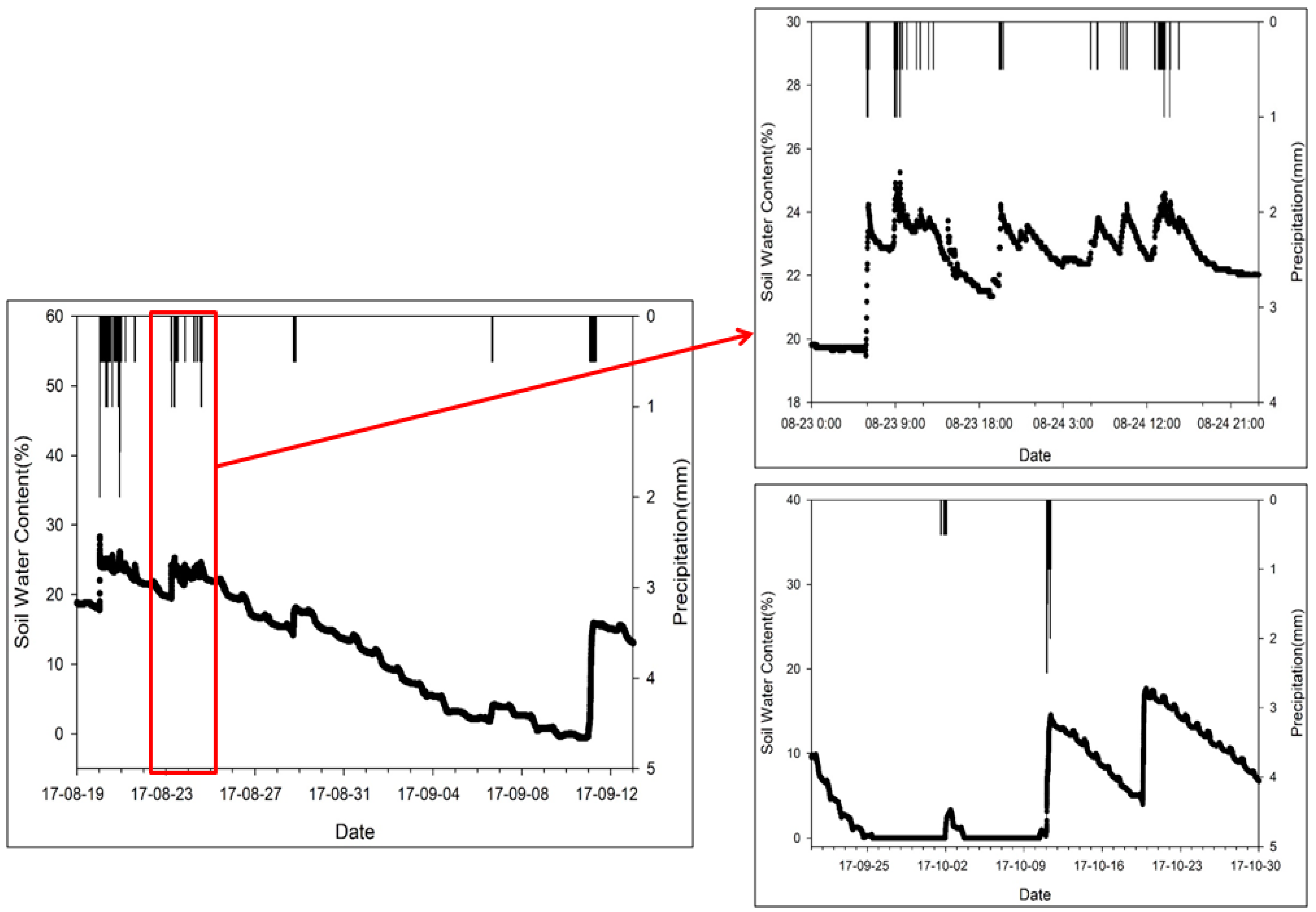
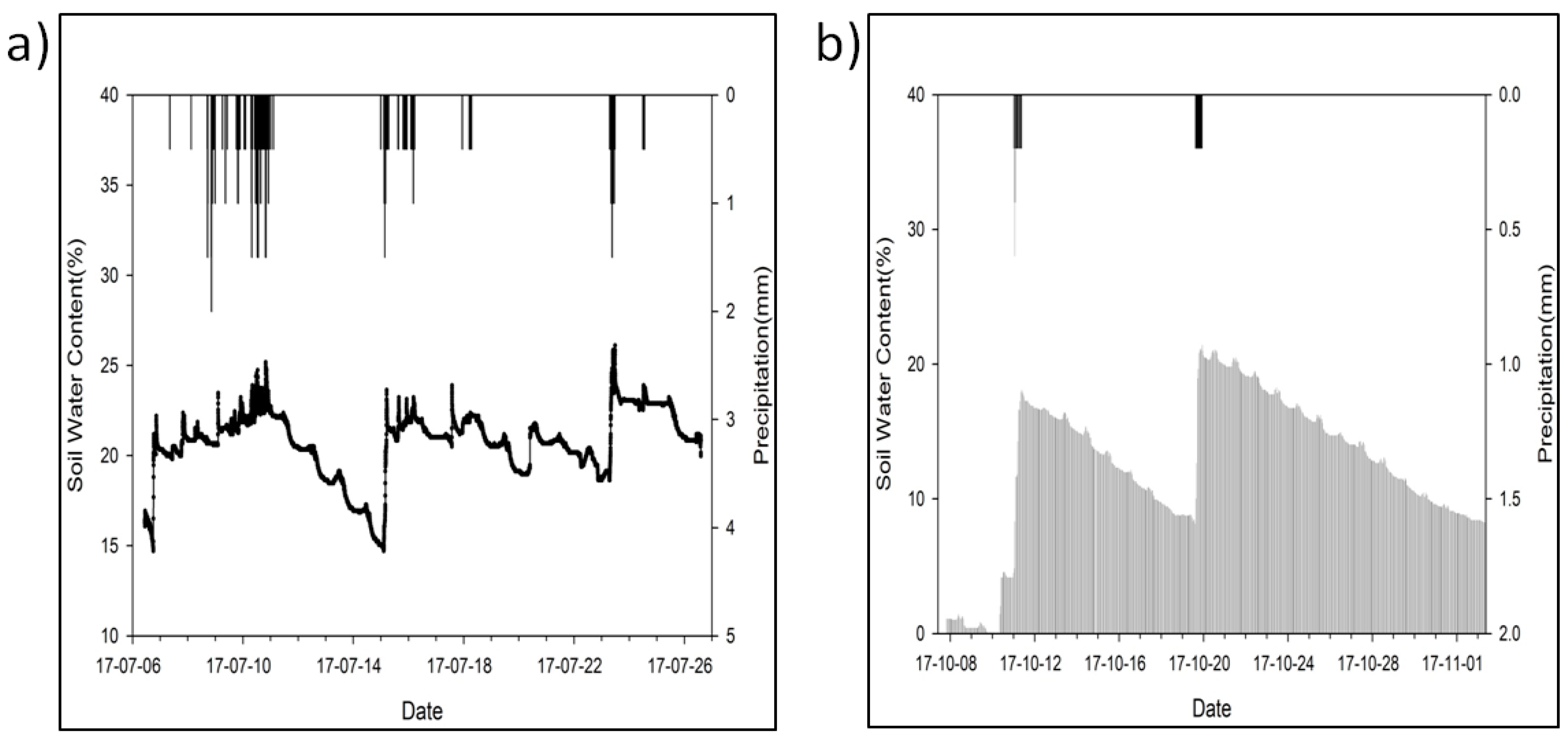
| References | Runoff Retention Value Observed (%) | Location |
|---|---|---|
| Stovin et al. (2012) [2] | 50.2 | Sheffield, UK |
| Stovin et al. (2013) [3] | 59.0 | Sheffield, UK |
| Seters et al. (2009) [23] | 63.0 | Toronto, Canada |
| Fioretti et al. (2010) [24] | 68.0 | Northwest and Central Italy |
| Palla et al. (2011) [25] | 68.0 | Genoa, Italy |
| Carter and Rasmussen (2006) [26] | 78.0 | Georgia, USA |
| Morgan et al. (2013) [27] | 50.0 | Michigan, USA |
| Getter et al. (2007) [28] | 80.8 | Michigan, USA |
| Carpenter and Kaluvakolanu (2011) [29] | 68.3 | Michigan, USA |
| Fassman-Beck et al. (2013) [30] | 56.0 | Auckland, New Zealand |
| Bengtsson (2005) [31] | 62.0 | Lund University, Sweden |
| Mentens et al. (2006) [1] | 76.0 | KU Leuven, Belgium |
| Köehler (2005) [32] | 77.0 | Univ. of Neubrandenburg, Germany |
| Centgraf (2005) [33] | 64.0 | Technical University of Berlin, Germany |
| Tillinger et al. (2006) [34] | 80.0 | Columbia University, New York, NY, USA |
| Prowell (2006) [35] | 78.0 | University of Georgia, Athens, GA, USA |
| Shafique et al. (2016) [5] | 68.0 | Seoul, Korea |
| No. | Characteristics | Seoul, Korea |
|---|---|---|
| 1 | Underlying roof type | Conventional concrete |
| 2 | Latitude, longitude (°) | 37°34′ N 126°56′ E |
| 3 | Roof area (m2) | 663 |
| 4 | Yearly rainfall (mm) | 1100~1360 |
| 5 | Monthly average temperature | 15 °C to 31 °C |
| 6 | Climate region | Humid continental (warm summers, cool winters) |
| 7 | Plant used in green roof | Sedum with mix vegetation |
| 8 | Soil media depth | 30 mm |
| Soil composition | Natural soil and organic matter | |
| Insulation layer depth | 40 mm |
© 2018 by the authors. Licensee MDPI, Basel, Switzerland. This article is an open access article distributed under the terms and conditions of the Creative Commons Attribution (CC BY) license (http://creativecommons.org/licenses/by/4.0/).
Share and Cite
Shafique, M.; Kim, R.; Kyung-Ho, K. Green Roof for Stormwater Management in a Highly Urbanized Area: The Case of Seoul, Korea. Sustainability 2018, 10, 584. https://doi.org/10.3390/su10030584
Shafique M, Kim R, Kyung-Ho K. Green Roof for Stormwater Management in a Highly Urbanized Area: The Case of Seoul, Korea. Sustainability. 2018; 10(3):584. https://doi.org/10.3390/su10030584
Chicago/Turabian StyleShafique, Muhammad, Reeho Kim, and Kwon Kyung-Ho. 2018. "Green Roof for Stormwater Management in a Highly Urbanized Area: The Case of Seoul, Korea" Sustainability 10, no. 3: 584. https://doi.org/10.3390/su10030584
APA StyleShafique, M., Kim, R., & Kyung-Ho, K. (2018). Green Roof for Stormwater Management in a Highly Urbanized Area: The Case of Seoul, Korea. Sustainability, 10(3), 584. https://doi.org/10.3390/su10030584






